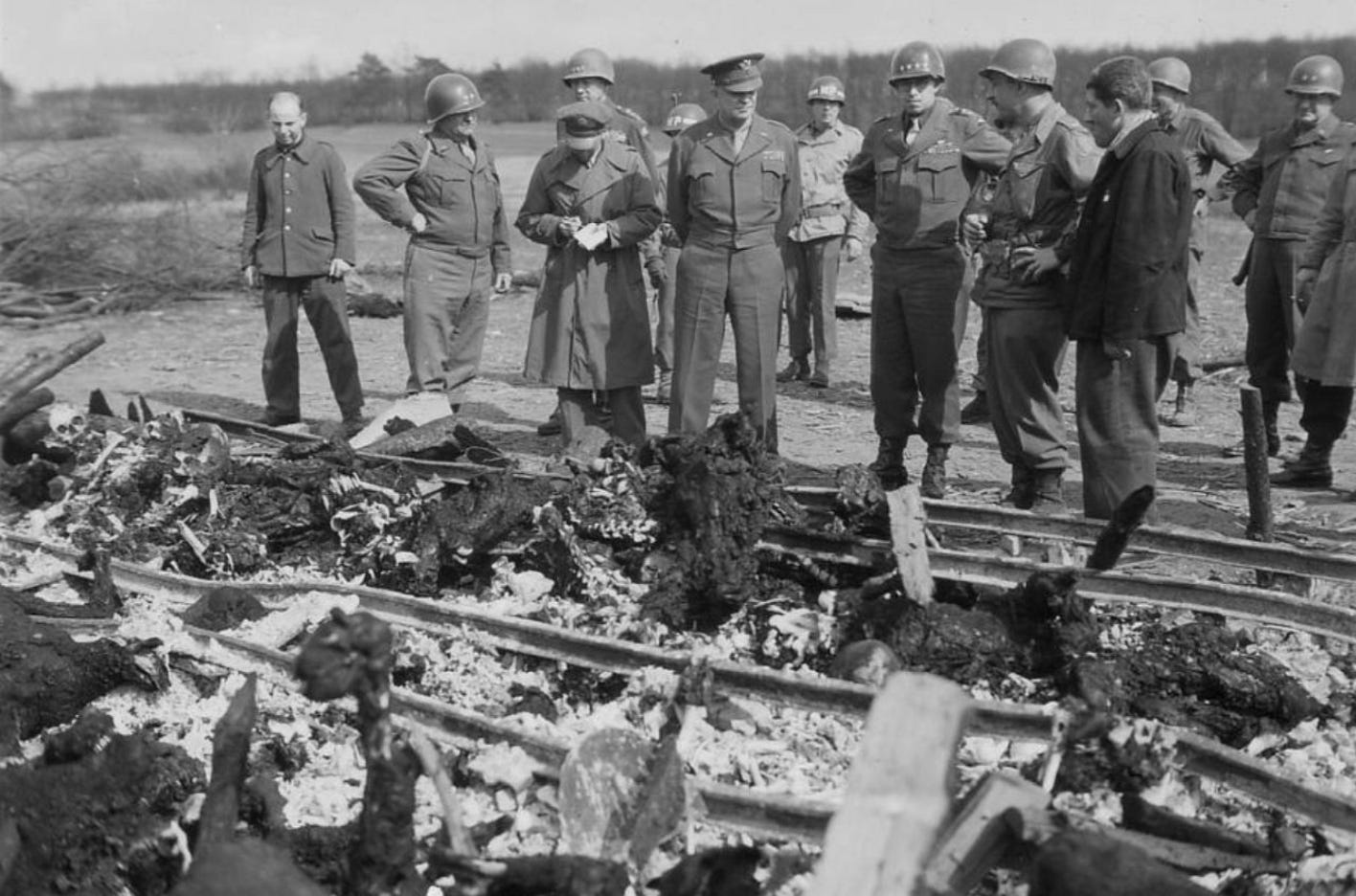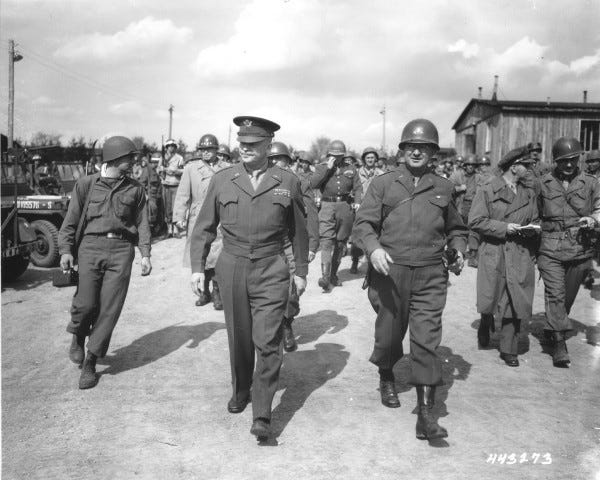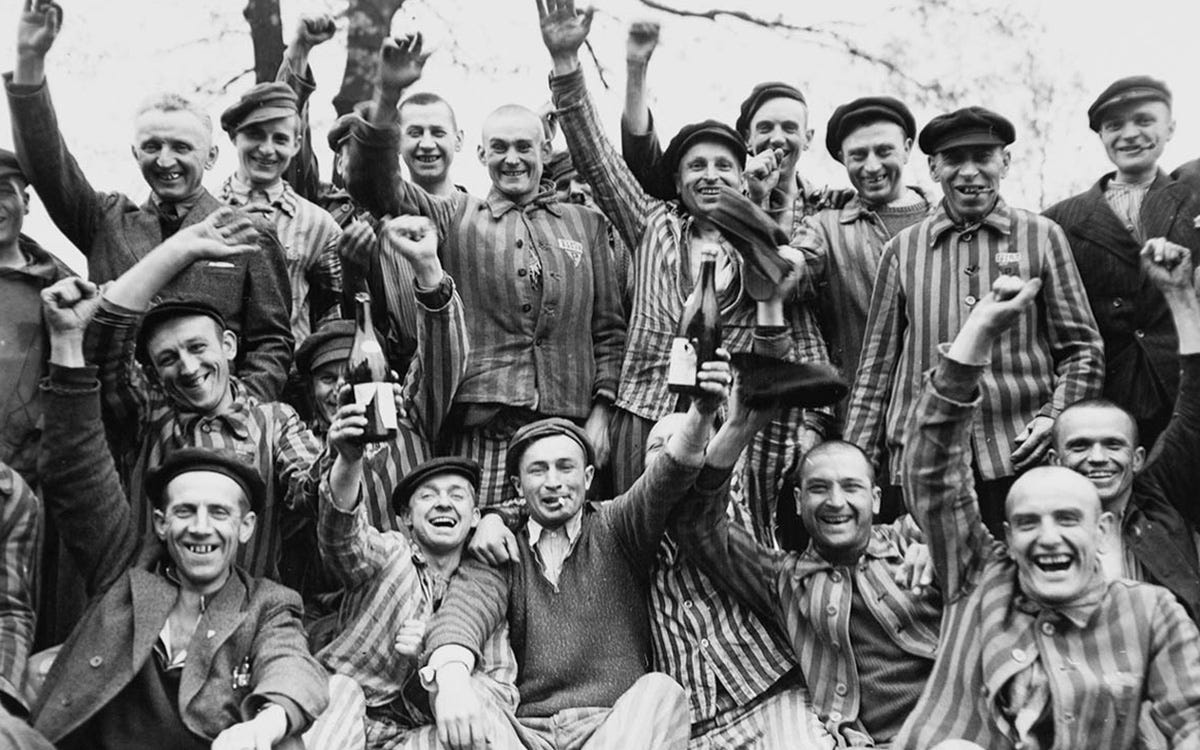Eighty years ago, in the charnel house that was the remains of the Third Reich, American soldiers liberated some of Nazi Germany’s most notorious concentration camps. Today, as the very last of the liberators and those liberated approach the end of their lives, it is appropriate to remember that April 1945 marked both an awakening and a warning.
Einsenhower, fourth from left, at Ohrdruf.
It was a month of horror and heroism. The first camp liberated by the U.S. Army was Ohrdruf on April 4. The camp was relatively new, established in November 1944, as part of a vast archipelago of suffering that stretched across Europe. By the time the Americans arrived, most of the camp’s inmates had died on death marches to Buchenwald.
Buchenwald itself was liberated a week later, on April 11. Some quarter of a million human beings had been imprisoned during the camp’s existence, over 50,000 of whom died. There were some 21,000 inmates alive when the Sixth Armored Division appeared
Eisenhower was both disgusted and enraged by what he saw on 12 April 1945.
The following day, April 12, Allied Supreme Commander Dwight Eisenhower arrived at Ohrdruf, accompanied by Generals George S. Patton and Omar Bradley. They were given a tour of hell by a Jewish-Austrian survivor. A grim-faced Eisenhower was nauseated and enraged by what he saw.
Eisenhower reported to George Marshall, Army Chief of Staff:
“The things I saw beggar description…In one room, where they were piled up twenty or thirty naked men, killed by starvation, George Patton would not even enter. He said that he would get sick if he did so. I made the visit deliberately, in order to be in a position to give first-hand evidence of these things if ever, in the future, there develops a tendency to charge these allegations merely to “propaganda.”
Eisenhower cabled Marshall on April 19, proposing that U.S. editors and politicians be sent to Germany to see the camps. There should be a record of the “bestiality and cruelty.”
On April 29, the subject of my book, The Liberator, Lt. Colonel Felix Sparks, led men from the 45th Infantry Division into Dachau. It was the first concentration camp set up by the Nazis in 1933, a model for thousands of camps that followed, and where SS guards were trained. At least 40,000 people had died of execution, malnutrition, disease, torture, and overwork by the time 26-year-old Lt. Colonel Sparks entered.
What Sparks and his men saw at Dachau would stay with them for the rest of their lives, forever etched in their memories. Thousands of corpses lay scattered throughout the camp. As Sparks later said, Dachau was “beyond the human imagination.”
Among the 30,000 inmates who greeted their liberators with a spine-chilling roar were around a thousand Catholic priests. The survivors came from more than 40 different countries. “All we could think about were Americans,” recalled one inmate. “It was truly our second birthday.”
Survivors of Dachau.
Sparks and his men were traumatized by what they witnessed 80 years ago. However, unlike tens of thousands of other US soldiers who had died on the long journey to Germany since July 1943, from Sicily through Italy and France, Sparks and his men finally understood why the sacrifice of so many friends had been necessary. “I’ve been in the army overseas in combat for 23 months,” recalled one liberator. “I’d gladly go through it all again if I knew things like this would be stopped.”
Eighty years after the camps were liberated, there are fewer and fewer people who can bear witness to the evils of the Third Reich and to the courage and resilience of those who helped end the Holocaust. I know of no living liberator from Sparks’ unit who can return to Dachau for commemorations this month.
Survivors of Dachau called 29 April 1945 “The Day of the Americans.”
Others must now tell the story of April 1945. Others must carry the torch. We at Friends of the National World War II Memorial are doing so, and we are determined to educate future generations about the men and women who united to defeat barbarism and set millions free around the globe. We owe it to Eisenhower, to the over 400,000 Americans who gave their lives in WWII, to our Allies, and to the countless victims of Nazism.









Many years ago I spoke with a man who was in the US Army and present at the liberation of Dachau. We had been talking about something else when I saw his framed photo in an Army uniform on a table. When I asked about it he told me what it had been like for him and he didn’t get too far before he began crying. It started with a few tears, then progressed to heartbreaking sobs. He recalled the terrible conditions, the dead bodies, all of it. And he was as grief stricken all those years later as he was when he first viewed the terribleness of Nazi rule. I’ll never forget the things he told me or how deeply it still affected him, but I understood how that experience had shaped his life.
During the late 1970s, I worked with a veteran of the 90th Division who had helped liberate a death camp. He said they picked up a horrific smell that stayed with them until broke out of a forest. At that point they could see living skeletons hanging on to a fence. He said they broke down the gate and killed all of the Germans. They then used up all of their medical supplies. The Division set up a field hospital. He said the troops couldn’t hold down food for a week. They saw piles of gold teeth, hair and clothing. The people in the town said they didn’t know the camp was there.